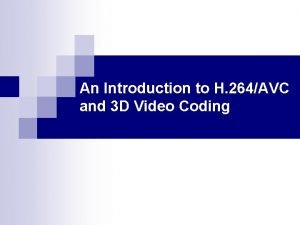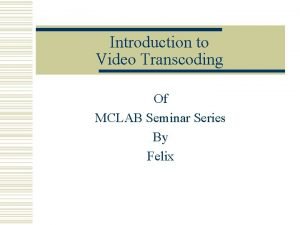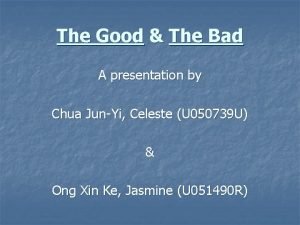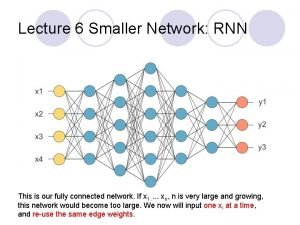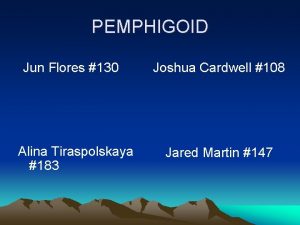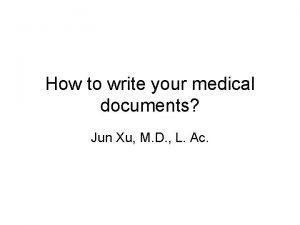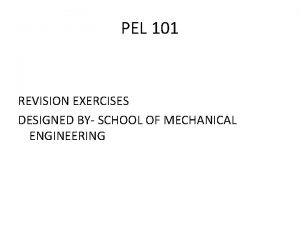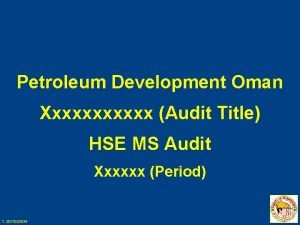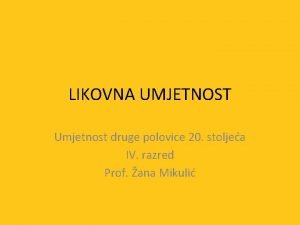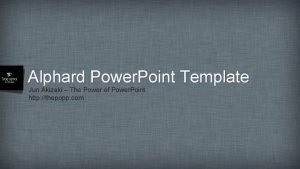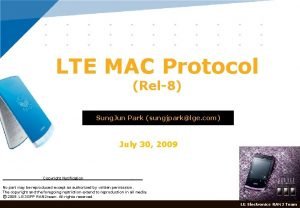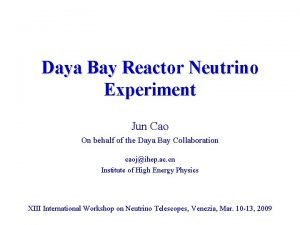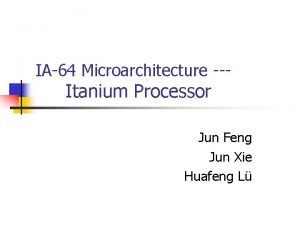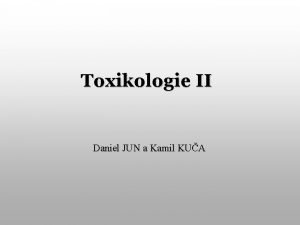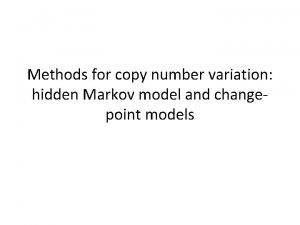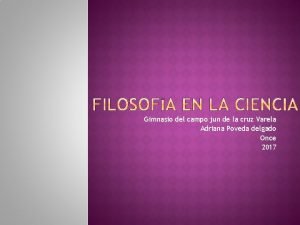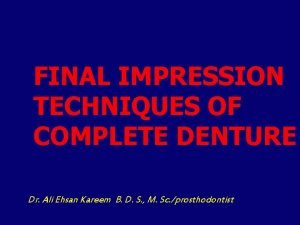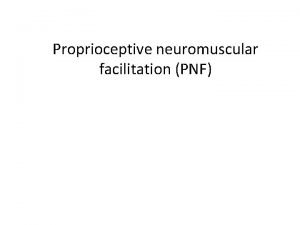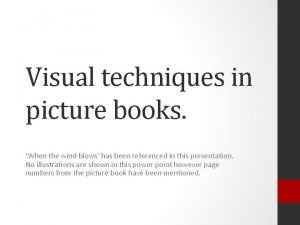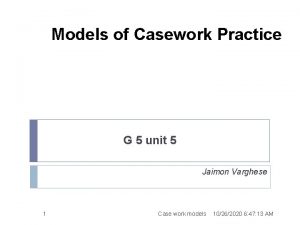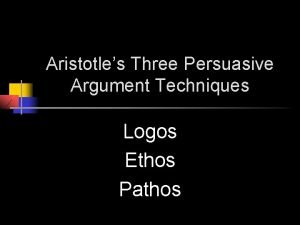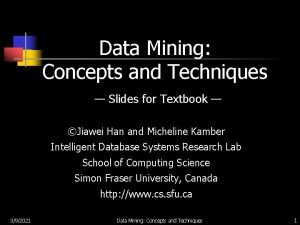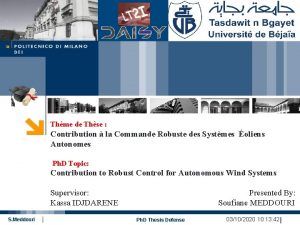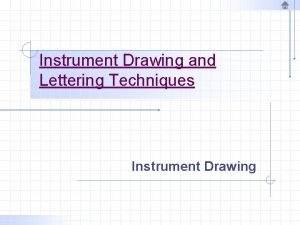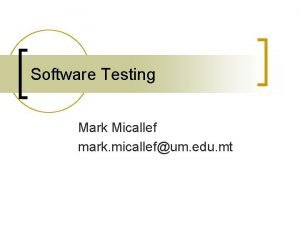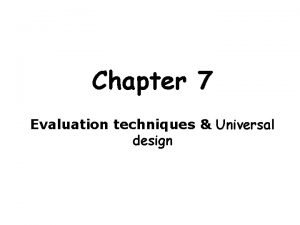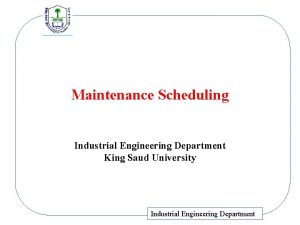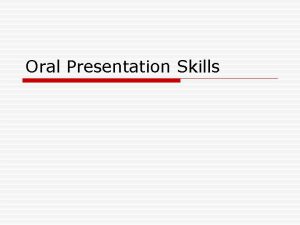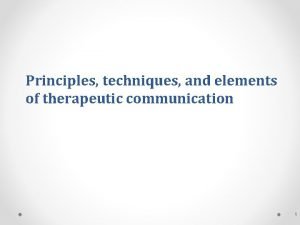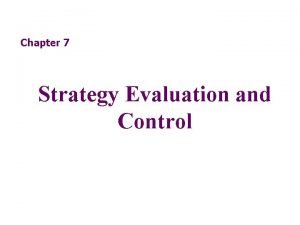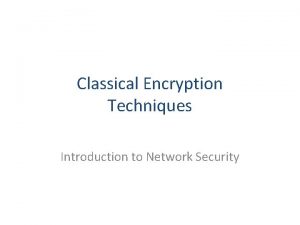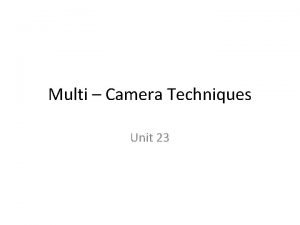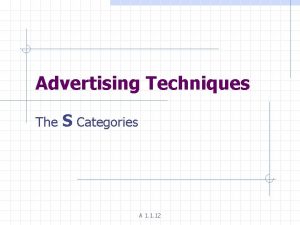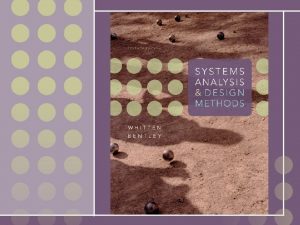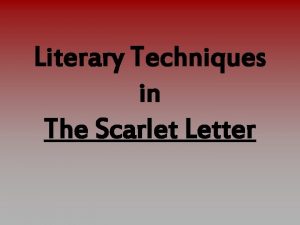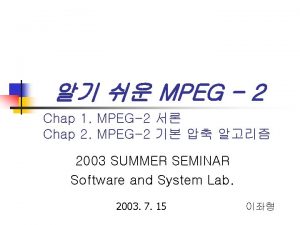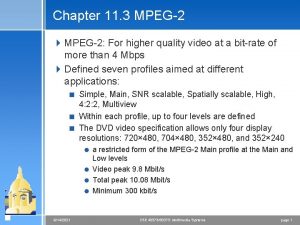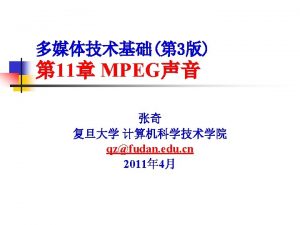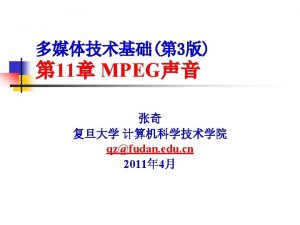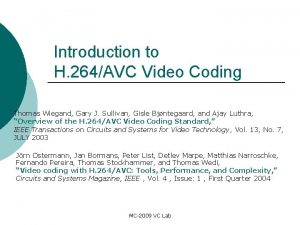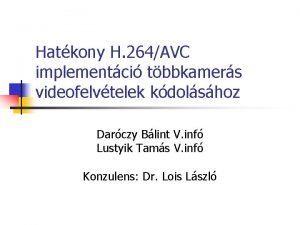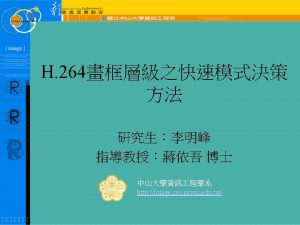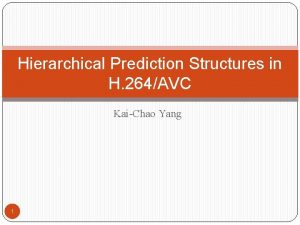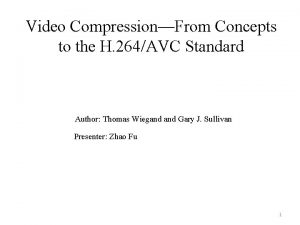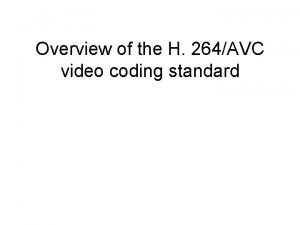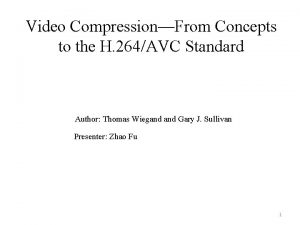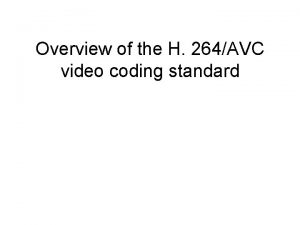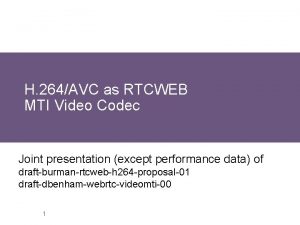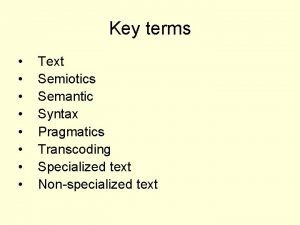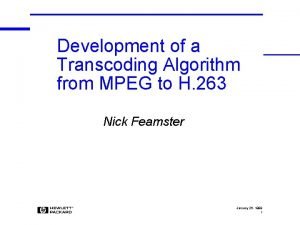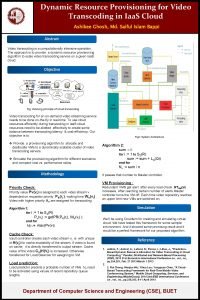MPEG2 to H 264AVC Transcoding Techniques Jun Xilient




















































- Slides: 52

MPEG-2 to H. 264/AVC Transcoding Techniques Jun Xilient Inc. Cupertino, CA

Digital Video Transcoder Coded digital video bit-stream “A” Coded digital video bit-stream “B” Transcoder n “A” and “B” may differ in many aspects: coding formats: e. g. MPEG-2 to H. 264/AVC ¨ bit-rate, frame rate, resolution … ¨ features: error resilience features ¨ contents: e. g. logo insertion ¨ November 07 Digital Video Transcoding

Applications n Media Storage Transcode broadcasting MPEG-2 video to H. 264/AVC format: enable long-time recording ¨ Effective for multi-channel recording ¨ n Home Gateway ¨ Provide connection to IPTV set-top box n n n Box only supports H. 264/AVC Over wireless network with bandwidth limitation Other potential uses: Export to mobile ¨ Internet streaming ¨ …… ¨ November 07 Digital Video Transcoding

Goals and Challenges n H. 264/AVC: latest video compression standard Promises same quality as MPEG-2 at half the bit-rate ¨ Is being widely adopted ¨ n n n Convert MPEG-2 video to H. 264/AVC format ¨ n HD Consumer Storage, e. g. , HD-DVD and Blu-Ray Mobile Devices, e. g. , Apple i. Pod, i. Phone, Sony PSP More efficient storage, export to mobile devices, etc. Challenges Yield similar quality as full re-encoding, but with much lower cost ¨ Key to lower-cost/high-quality: how to intelligently reuse available information from the incoming bitstream ¨ May be loosely considered as a “two-pass coder” ¨ n November 07 Could achieve better quality than full re-encoding given same complexity Digital Video Transcoding

Outline n Intra-only transcoding techniques ¨ Efficient n compressed domain processing Inter transcoding techniques ¨ Motion November 07 mapping / motion reuse Digital Video Transcoding

Intra Transcoding Techniques

Intra Transcoder – Pixel Domain Input MPEG-2 Bitstream VLD: variable length decoding (I)Q: (inverse) quantization IDCT: inverse discrete cosine transform HT: H. 264/AVC 4 x 4 transform VLD/ IQ HT IDCT H. 264 Entropy Coding Q Inverse HT Intra Prediction (Pixel-domain) November 07 Mode decision Digital Video Transcoding Pixel Buffer

Compressed Domain Processing? Input MPEG-2 Bitstream VLD: variable length decoding (I)Q: (inverse) quantization IDCT: inverse discrete cosine transform HT: H. 264/AVC 4 x 4 transform VLD/ IQ H. 264 Entropy Coding Q Inverse Q Intra Prediction (Comp-domain) November 07 Mode decision Digital Video Transcoding Coeff Buffer

AVC 4 x 4 Transform n n Motivation: ¨ DCT requires real-number operations, which may cause inaccuracies in inversion ¨ Better prediction means less spatial correlation – no strong need for real-number operations H. 264 uses a simple integer 4 x 4 transform ¨ Approximation to 4 x 4 DCT ¨ Transform and inverse transform n November 07 note: ½ in inverse transform represents right shift, so it is non-linear Digital Video Transcoding

Intra Prediction in H. 264/AVC n n Motivation: intra-frames are natural images, so they exhibit strong spatial correlation Pixels in intra-coded frames are predicted based on previously-coded ones ¨ n Prediction can be based on 4 x 4 blocks or 16 x 16 macroblocks (or 8 x 8 blocks for high profile) An encoded mode specifies which neighbor pixels should be used to predict, and how November 07 Digital Video Transcoding

4 x 4 Intra Prediction Example n Current block: n Prediction blocks: Vertical November 07 Horizontal Digital Video Transcoding Diagonal_Down_Right

Compressed Domain Processing? n Challenges ¨ Different transforms n MPEG-2 uses DCT, floating point n H. 264/AVC uses an integer transform ¨ New prediction modes in H. 264/AVC n Can prediction be performed in compressed domain? n Goals ¨ Simpler November 07 computation and architecture Digital Video Transcoding

Compressed Domain Processing? Input MPEG-2 Bitstream VLD: variable length decoding (I)Q: (inverse) quantization IDCT: inverse discrete cosine transform HT: H. 264/AVC 4 x 4 transform VLD/ IQ H. 264 Entropy Coding Q Inverse Q Intra Prediction (Comp-domain) November 07 Mode decision Digital Video Transcoding Coeff Buffer

Intra Transcoder – Proposed Input MPEG-2 Bitstream VLD: variable length decoding (I)Q: (inverse) quantization IDCT: inverse discrete cosine transform HT: H. 264/AVC 4 x 4 transform VLD/ IQ DCT-to-HT conversion (S-Transform) Entropy Coding Q Inverse HT Intra Prediction (HT-domain) Mode decision (HT-domain) November 07 Digital Video Transcoding Pixel Buffer

Techniques n DCT-to-HT conversion n Compressed (HT) domain prediction ¨ Very simple for some prediction modes n Compressed domain distortion calculation in mode decision n Advantages ¨ lower computational complexity ¨ No quality loss November 07 Digital Video Transcoding

DCT-to-HT Conversion November 07 Digital Video Transcoding

DCT-to-HT Conversion: Transform Kernel Matrix November 07 Digital Video Transcoding

Fast Algorithm (1 D) November 07 Digital Video Transcoding

Complexity Analysis n Transform-domain DCT-to-HT (S-Transform): 704 operations ¨ ¨ n Pixel-domain mapping (IDCT* followed by HT): 992 operations ¨ ¨ ¨ n 352 multiplications 352 additions 256 multiplications 64 shifts 672 additions Advantage ¨ ¨ ¨ 29% saving in total operations Two-stage vs. six-stage implementation Better performance: no intermediate rounding W. H. Chen, C. H. Smith, and S. C. Fralick, ``A Fast Computational Algorithm for the Discrete Cosine Transform, '' IEEE Trans. on Communications, Vol. COM-25, pp. 1004 -1009, 1977 * November 07 Digital Video Transcoding

Intra Transcoder – Proposed Input MPEG-2 Bitstream VLD: variable length decoding (I)Q: (inverse) quantization IDCT: inverse discrete cosine transform HT: H. 264/AVC 4 x 4 transform VLD/ IQ DCT-to-HT conversion (S-Transform) Entropy Coding Q Inverse HT Intra Prediction (HT-domain) Mode decision (HT-domain) November 07 Digital Video Transcoding Pixel Buffer

Conventional Mode Decisions n Given all possible prediction modes, encoder needs to decide which one to use n Low-complexity mode decision rule (RDO_Off): SATD Cost or n High-complexity mode decision rule with rate distortion optimization (RDO_On): RD Cost November 07 Digital Video Transcoding

Conventional RD Cost Computation n Entire encoding/decoding need to be performed for every mode November 07 Digital Video Transcoding

Motivation & Previous Approaches n RD_Cost based mode decision gives best performances, but very expensive to compute n Previous efforts in fast intra mode decisions ¨ Directional field ¨ Edge histogram ¨ Other pixel-domain approaches ¨ They all lead to lower coding performance n Our approach is based on transform domain processing – no loss in coding performance November 07 Digital Video Transcoding

Transform Domain RD Cost Computation No inverse transform ¨ Transformations of some prediction signals are easy to compute ¨ Distortion calculated in transform domain ¨ November 07 Digital Video Transcoding

HT of DC Prediction HT • • No HT needs to be performed Pdc has only one non-zero elements November 07 Digital Video Transcoding

HT of Horizontal Prediction • • Only one 1 -D HT is needed Ph has only four non-zero elements (the first column) November 07 Digital Video Transcoding

HT of Vertical Prediction • • Only one 1 -D HT is needed Pv has only four non-zero elements (the first row) November 07 Digital Video Transcoding

Calculate Distortion in Transform Domain Distortion in pixel domain: Distortion in transform domain: November 07 Digital Video Transcoding

Ranking-based Fast Mode Decision n Two cost functions: SATD_Cost & RD_Cost n Observation: the best mode according to RD_Cost usually has smaller SATD_Cost n Proposed algorithm (mode reduction): to rank different modes using SATD_Cost, then calculate RD_Cost for top several modes ¨ Algorithm can be conducted in transform domain November 07 Digital Video Transcoding

Verification Experiment n Count the percentage of times when the best mode according to RD_Cost are within the best k modes ranked by SATD_Cost ¨ k fixed as 3 in all simulations November 07 Digital Video Transcoding

Simulation Conditions n Three transcoders PDT – reference pixel domain transcoder, with fast IDCT implemented ¨ TDT – transform domain transcoder ¨ TDT-R – transform domain transcoder with ranking-based mode decision ¨ n Test sequences 100 frames, CIF size, 30 fps ¨ Input: MPEG-2 all-I at 6 Mbps ¨ November 07 Digital Video Transcoding

Simulation – “Mobile” November 07 Digital Video Transcoding

Simulation – “Stefan” November 07 Digital Video Transcoding

Complexity: Run-time Results November 07 Digital Video Transcoding

Summary of Intra Transcoding n Efficient transcoder architecture n Efficient mode decision ¨ Transform domain distortion calculation ¨ Ranking-based mode decision n Achieved virtually same quality as reference transcoder with significantly lower complexity November 07 Digital Video Transcoding

Inter Transcoding Techniques

Transcoder Architecture entropy coding HT/Q Inverse Q/ Inverse HT Decoded picture and macroblock data Prediction MPEG-2 decoder Deblocking filter Pixel buffers Motion and modes Motion/mode mapping November 07 Digital Video Transcoding

Assumptions n Input ¨ MPEG-2 n frame pictures Output ¨ H. 264/AVC baseline profile (no B slices) and main profile ¨ Frame pictures, MBAFF not considered ¨ Block partition sizes considered for motion compensation: 16 x 16, 16 x 8, 8 x 16 and 8 x 8 November 07 Digital Video Transcoding

Motion Mapping: Problems MPEG-2 H. 264/AVC Frame/field motion vector Frame motion vector B, P pictures Baseline profile has no B picture support Motion vectors for different partition sizes: 16 x 16, 16 x 8, 8 x 16, 8 x 8 One motion vector per macroblock November 07 Digital Video Transcoding

Motion Mapping Algorithm 1. 2. 3. Field-to-frame mapping: convert MPEG-2 field motion vectors (if any) to frame vector Reference picture mapping: for B to P frame type conversion Block size mapping: map the MPEG-2 motion vectors to target H. 264/AVC motion vectors of different block size n Algorithm: distance weighted average (DWA) 4. Motion refinement: (1+1/2+1/4) around estimated motion vectors for all block partitions n Note: for B slice output, the above mapping is performed for motion vectors of both directions November 07 Digital Video Transcoding

Field-to-frame Conversion November 07 Digital Video Transcoding

Reference Picture Mapping ti=3 Input I B B P Output I P P P to=1 MVcol MVi, forw MVi, back Input I B B P Output I P P P November 07 MVo Digital Video Transcoding

Block Size Mapping: 16 x 8 8 x 16 November 07 Digital Video Transcoding

Block Size Mapping: 8 x 8 November 07 Digital Video Transcoding

Simulation Conditions n Test sequences: ¨ n MPEG-2 input: ¨ n 30 Mbps, (30, 3) H. 264/AVC output: ¨ ¨ n 1920 x 1080 i, 30 fps, 450 frames UVLC, output bit-rate of interest ~10 Mbps Baseline profile (needs to convert B pictures to P slices) & Main profile Comparison points ¨ ¨ ¨ Mapping algorithm B slices RD optimization November 07 Digital Video Transcoding

Baseline output: no B slices November 07 Digital Video Transcoding

Baseline output: no B slices November 07 Digital Video Transcoding

Main Output: with B slices November 07 Digital Video Transcoding

Main Output: with B slices November 07 Digital Video Transcoding

Complexity: Run-time Results November 07 Digital Video Transcoding

Conclusions n Efficient motion mapping schemes that directly map MPEG-2 motion vectors to H. 264/AVC motion vectors n Evaluated the complexity-performance tradeoff of B-slices and RD optimization n Achieved good rate-distortion performance with low complexity November 07 Digital Video Transcoding

Thank you
 H.264avc
H.264avc Video transcoding basics
Video transcoding basics Difference between mpeg1 and mpeg2
Difference between mpeg1 and mpeg2 Psip generator
Psip generator Chua jun yi
Chua jun yi Yt
Yt Jun flores
Jun flores Jun xu md
Jun xu md The eight slots on pam's extra large toaster
The eight slots on pam's extra large toaster Oman xxxxxx
Oman xxxxxx Jun feb mar
Jun feb mar Tašizam
Tašizam Jun akizaki
Jun akizaki Semi persistent scheduling
Semi persistent scheduling Jun cao
Jun cao Www.brainybetty.com
Www.brainybetty.com Ppt-51
Ppt-51 Intel itanium
Intel itanium 55+46
55+46 Jun akizaki ppt
Jun akizaki ppt Daniel jun
Daniel jun Jun s. liu
Jun s. liu Gimnasio jun
Gimnasio jun Fonctions et solutions techniques
Fonctions et solutions techniques Boxing complete denture
Boxing complete denture Pnf stretching pdf
Pnf stretching pdf Examples of visual techniques
Examples of visual techniques Models of casework
Models of casework Professional selling skills miller heiman
Professional selling skills miller heiman Logos ethos pathos
Logos ethos pathos Data mining concepts and techniques slides
Data mining concepts and techniques slides Database recovery techniques
Database recovery techniques Direct method of learning
Direct method of learning Direct guidance examples
Direct guidance examples Control techniques
Control techniques Persuasive devices
Persuasive devices Lettering techniques in engineering drawing
Lettering techniques in engineering drawing Dr mark micallef
Dr mark micallef Evaluation techniques
Evaluation techniques Maintenance scheduling techniques
Maintenance scheduling techniques Effective oral presentation techniques
Effective oral presentation techniques Components of therapeutic communication
Components of therapeutic communication Evaluation and control
Evaluation and control 819 mod 26
819 mod 26 Yoyo techniques
Yoyo techniques Advantages of multi camera production
Advantages of multi camera production Smiley face techniques
Smiley face techniques Technique immunologique annaba
Technique immunologique annaba Language
Language Paralleism
Paralleism What are advertising techniques
What are advertising techniques Requirements discovery techniques
Requirements discovery techniques The scarlet letter literary devices
The scarlet letter literary devices
